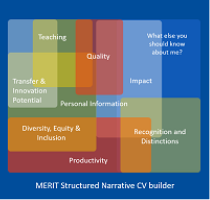About
What Are Narrative CVs?
Across the globe, many research organizations—including funders, universities, and research institutes—are revising how they evaluate research. As part of these reforms, narrative CVs, or elements thereof, are being introduced into application processes, replacing traditional listed CVs that emphasize productivity metrics, such as journal-based citation counts or amount of acquired 3rd party funding. These metrics have proven inadequate for assessing an individual’s research performance comprehensively or for makijng robust conclusions about the quality or practical impact of the work. Narrative CVs align well with international recommendations, such as those from the Coalition for Advancing Research Assessment (CoARA), the Declaration on Research Assessment (DORA), or Science Europe.
The objective of narrative CVs is to make research evaluations and selection processes fairer, more reflective of current research practices, and better suited to recognizing the diversity of a researchers activities and contributions as well as the practical and societal impact of (biomedical) research.
Prominent institutions that have adopted or are in the process of adopting narrative CV elements include the European Research Council (ERC), the Deutsche Forschungsgemeinschaft (DFG), the Luxembourg National Research Fund (FRN), the Royal Society (UK), the Swiss National Science Foundation, the UK Research and Innovation (UKRI), the National Institutes of Health (NIH), the Yale School of Medicine, and the Charité Universitaetsmedizin Berlin among many others.
Why Use the MERIT Structured Narrative CV?
Various institutions have developed their own templates for narrative CVs. While entirely narrative CVs allow a a lot of creative freedom to the applicant, they can be difficult to compare for reviewers, especially when a clear structure and guidance on the desired content is missing. Similar to the Swiss National Fund or the University of Glasgow, the MERIT structured narrative CV builder combines qualitative and quantitative criteria in a structured, hybrid format. This approach integrates quality- and impact-oriented aspects alongside productivity metrics, offering a multidimensional perspective that contextualizes the applicant’s performance.
The MERIT structured narrative CV allows researchers to highlight the diversity of their research outputs and activities specific to their field, reflect on their work, and contextualize their contributions to both research or society. The structured format is supported by clear instructions and character limits. It also aids reviewers by facilitating easier comparisons between applicants and providing deeper insights into a researcher’s accomplishments.
The structured format not only enhances fairness in the application process by promoting transparency but also reduces the potential for reviewer bias.
The development of the the MERIT CV is based on a needs assessment and evaluation within Charité and BIH. It incorporates requirements and feedback from the stakeholders and users (applicants, reviewers and science managers). While some of the requirements are specific to the biomedical field or life sciences, most of the elements are relevant to other fields as well.
MERIT users can input responses to various criteria and generate a customized narrative CV in PDF or MS Word format for reuse in future applications.
What Criteria and Indicators Are Included in the MERIT Structured Narrative CV?
The MERIT CV builder encompasses eight criteria (see image), along with an additional field for users to include relevant information not explicitly requested. Each criterion is supported by multiple indicators, providing the reader with both information and context. Some indicators require concise narratives, while others rely on traditional lists.
Applicants have the flexibility to decide which sections to complete and include in their CV, tailoring the document to best represent their achievements and activities relevant to their field or requirements of the application.

Risk of Bias during Assessments for Hiring, Grant or Fund Allocations
We all, often unconsciously, harbor biases toward others and in our judgments (known as unconscious or implicit bias). These biases influence how we subconsciously evaluate options and make decisions. While bias does not always result in poorer decisions, it has been shown to lead to unfair assessments in contexts such as hiring or allocation of funds, which can undermine fairness and the assessment of quality or performance-oriented goals. Common forms of unconscious bias include:
- Anchoring bias: Initial information is subconsciously used as a benchmark for further evaluation.
- Availability bias: Anecdotal or selective information unconsciously shapes judgments.
- Confirmation bias: Evaluations are subconsciously interpreted to align with preexisting beliefs.
- Ingroup bias: Favorable evaluations or resources are unconsciously allocated to members of one's own group or peers.
The video below provides just under 8 minutes of information on common forms of (unconscious) bias in recruitment.
“Recruitment Bias in Research Institutes” (7:50 min) - YouTube Video
The TU Berlin offers an unconscious bias training course on the topic of equal opportunities in appointment procedures (duration 40-60 minutes), which can be accessed via the following link: https://www.twillo.de/edu-sharing/components/render/7a279b2f-90d6-4245-9108-8e905f03a5a9.
Unconscious bias training is also offered by the University of Konstanz (duration approx. 2 hours). In this self-learning tool developed by Dr. Sebastian Tillmann et al. you can acquire basic knowledge on the topic of unconscious bias, find out what biases there are and where they occur and learn from practical examples how they can be avoided (https://www.uni-konstanz.de/unconscious-bias-tool/#/).
Author: Miriam Kip (2025)

CC BY-NC-ND 4.0